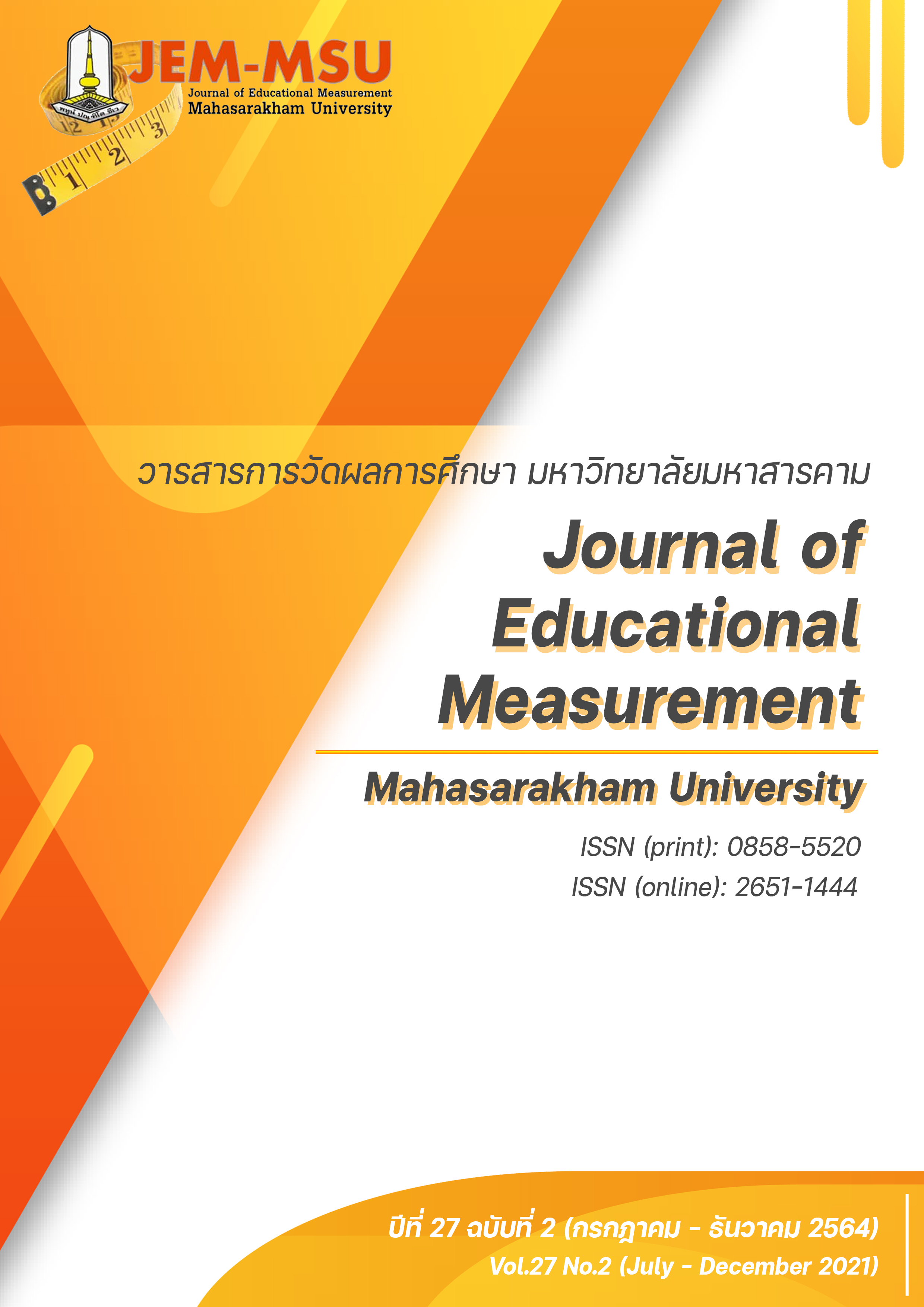Guidelines for Competency-Based Assessment in 21st Century
Main Article Content
Abstract
Provision of competency-based education is providing education with a competency-based curriculum system, competency-based learning and teaching, and competency-based assessment. The Ministry of Education has set guidelines for the development of learners’ competency at the basic education level. It aims to equip the learners with essential skills needed in the 21st century by giving the learners the opportunity to learn according to their interests and aptitudes and to progress according to their own abilities, with the aim of creating the core competencies necessary for their working, problem solving and living. The competency-based assessment in the 21st century comprises: (1) assessment for learning, assessment for diagnosis of learning problems of the learners, using a formative assessment model; (2) assessment while learning, to help the learners to become aware of their own learning, and to help students to design learning for continuous self-improvement, using a formative assessment model; and (3) evaluation of learning outcomes. It is an assessment to judge whether or not the learning outcomes have met the approved curriculum standards. The assessment uses a summative assessment. Evaluation can take a variety of formats: observation, demonstration and questioning, quizzes and subjective exams which are used to assess knowledge. Oral exams, project work, simulation or portfolios are also used. The core competencies used in measurement and evaluation are five essential competencies necessary for successful living and working: management, communication, teamwork, advanced thinking and strong citizenship. These will be the core components in setting the goals of developing the learners in the competency-based curriculum in order for them to have the essential skills needed in the 21st century for working, problem solving and living their own life in the future.
Article Details
The content and information contained in the published article in the Journal of Educational Measurement Mahasarakham University represent the opinions and responsibilities of the authors directly. The editorial board of the journal is not necessarily in agreement with or responsible for any of the content.
The articles, data, content, images, etc. that have been published in the Journal of Educational Measurement Mahasarakham University are copyrighted by the journal. If any individual or organization wishes to reproduce or perform any actions involving the entirety or any part of the content, they must obtain written permission from the Journal of Educational Measurement Mahasarakham University.
References
กรมพัฒนาฝีมือแรงงาน. (2557). กรอบและแนวทางการจัดทำหลักสูตรตามความสามารถ Developing A Competency Based Curriculum. กรุงเทพฯ: สำนักพัฒนาผู้ฝึกและเทคโนโลยีการฝึก, ฝ่ายพัฒนาระบบและรูปแบบการฝึกตามความสามารถ (CBT).
คณะทำงานวางแผนจัดทำกรอบสมรรถนะ. (2562). แนวทางการพัฒนาผู้เรียนให้เกิดสมรรถนะหลักที่จำเป็นต่อชีวิต. รายการผลงาน สื่อ สิ่งพิมพ์ ประชาสัมพันธ์ และเผยแพร่กรอบสมรรถนะผู้เรียน ระดับการศึกษาขั้นพื้นฐาน [ออนไลน์]. ได้จาก https://www.thaiedreform.org/wp-content/uploads/2019/08/Core_competency09.pdf/ [สืบค้นเมื่อ 10 มีนาคม 2563].
เฉลิมชัย พันธ์เลิศ. (2562). พัฒนาการหลักสูตรและการจัดการเรียนการสอน: จากอดีตสู่ยุคเปลี่ยนผ่านสู่หลักสูตรฐานสมรรถนะ (Competency). รายการผลงาน สื่อ สิ่งพิมพ์ ประชาสัมพันธ์ และเผยแพร่กรอบสมรรถนะผู้เรียน ระดับการศึกษาขั้นพื้นฐาน [ออนไลน์]. ได้จาก https://www.thaiedreform. org/wpcontent/uploads/2019/08/Core_competency09.pdf/[สืบค้นเมื่อ 10 มีนาคม 2563].
ธำรง บัวศรี. (2535). ทฤษฎีหลักสูตร : การออกแบบและพัฒนา. กรุงเทพฯ: โรงพิมพ์คุรุสภา.
พัชรี สร้อยสกุล. (2559). การพัฒนาทักษะแห่งศตวรรษที่ 21 สำหรับนักศึกษาอาชีวเอกชนในเขตพัฒนาอุตสาหกรรมชายฝั่งทะเลตะวันออก. วิทยานิพนธ์ปริญญาดุษฎีบัณฑิต. ชลบุรี : มหาวิทยาลัยบูรพา, คณะศึกษาศาสตร์, สาขาวิชาการบริหารการศึกษา.
วรรณ์ดี แสงประทีปทอง (2561). แนวทางการประเมินผลการเรียนรู้ในศตวรรษที่ 21. วารสารวิจัยและประเมินผลอุบลราชธานี, 7(1), 1-10.
วัฒนาพร ระงับทุกข์. (2563). สมรรถนะเด็กไทยในยุคโลกพริกผัน (VUCA World). วารสารครุสภาวิทยาจารย์, 1(1), 8-18.
สวนันท์ แดงประเสริฐ และภาวพรรณ ขำทับ. (2562). การพัฒนาโครงสร้างหลักสูตรฐานสมรรถนะตามมาตรฐานอาชีพ. วารสารพัฒนาเทคนิคการศึกษา, 32(112), 27-36.
สำนักงานเลขาธิการสภาการศึกษา. (2562). แนวทางการพัฒนาสมรรถนะผู้เรียนระดับการศึกษาขั้นพื้นฐาน. กรุงเทพฯ: บริษัท 21 เซ็นจูรี่ จำกัด.
สุจิตรา ปทุมลังการ์. (2552). ความรู้เกี่ยวกับหลักสูตรฐานสมรรถนะและการประเมินผล. หนังสือพิมพ์สำนักมาตรฐานการอาชีวศึกษาและอาชีพ ฉบับเดือนมกราคม 2552, 1-11.
Bergsmann, E., Schultes, M., Winter, P., Schober, B., & Spiel, C. (2015). Evaluation of competence-based teaching in higher education: From theory to practice. Evaluation and Program Planning, 52, 1-9.
Competency Based Training. (1992). A Practical Guide for Frontline Trainers. National Centre for Competency Based Training. Australia.
Lopez, N., Patrick, S., Sturgis, C., Rudenstine, A., Bacallao, D., Schaef, S., Worthen, M., Frost, D., Truong, N., AJones, A., & Abel, N. (2017). Quality and equity by design: charting the course for the next phase of competency-based education. NY: Creative Commons Attribution 4.0 International license.
McClelland, D.C. (1973). Test for Competence Rather Than for “Intelligence”[Online]. American Psychologist, 28(1), 1-14. Available from https://doi.org/10.1037/h0034092. [accessed 8 August 2020].
McClelland, D.C. (1976). The Achieving Society. New York: Irvington.
Mohammed K., I., Meriem, H., & Sanir, B. (2016). Competency-Based Assessment: From Conceptual Model to Operational Tool. [Online]. Mohammed V University in Rabat, Researchgate.net. Available from http://www.igi-global.com/chapter/competency-based-assessment/159967?camid=4v1. [accessed 8 August 2020].
MuñozI, D.R. & Araya, D.H. (2017). The challenges of competence-based assessment in the educational field. Educação e Pesquisa, 43(4): 1073-1086. Available from http://dx.doi.org/10.1590/ S1678-4634201706164230. [accessed 8 August 2020].
Salling Olesen, H.(2020). The challenge of competence assessment: Problematizing institutional regimes–Proclaiming a paradigm shift?. [Online]. Leiden: koninklijke brill nv. Available from https://doi.org/10.1163/9789004413320_007. [accessed 8 August 2020].
Suresh Kumar, P. M & Aithal, P. S. (2019). Competency assessment and grading in higher education. [Online]. SCHOLEDGE International Journal of Multidisciplinary & Allied Studies, 6(12): 127-136. Available from https://link.thescholedge.org/1132. [accessed 12 August 2020].
Tejada, J. & Ruíz, C. (2016). Evaluación de competencias profesionales en educación superior: retos e implicaciones. Educacion XXI, Madrid, 19(1), 17-38.


